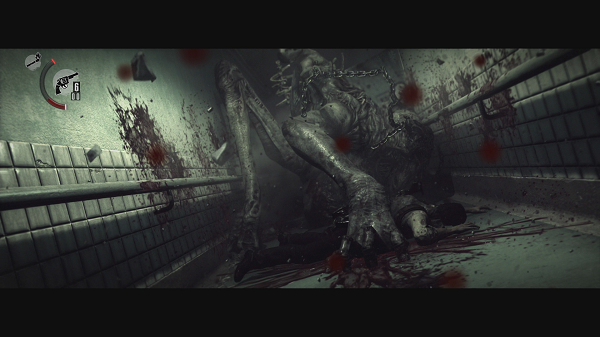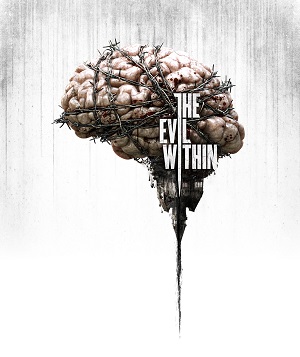 PLATFORM: PC, PS3, Xbox 360, Xbox One, PS4 (Reviewed)
PLATFORM: PC, PS3, Xbox 360, Xbox One, PS4 (Reviewed)
PRICE: $60
ESRB RATING: M
PUBLISHER: Bethesda Softworks
DEVELOPER: Tango Gameworks
GET IT ON STEAM: Here
GET IT ON AMAZON: Here
Horror games have experienced something of a renaissance in recent years, with titles such as Amnesia: The Dark Descent, Slender and Hideo Kojima/Guillermo del Toro’s recent, batshit P.T. demo pushing the boundaries of how video games can be used to scare the bejeezus out of us. This has understandably led to a resurgence of interest in the major survival horror franchises, with Kojima and del Toro now putting together a new Silent Hill instalment and Capcom releasing (and re-releasing) Resident Evils like it’s a fire sale.
In this climate, it’s natural that some of survival horror’s past stars would come forward with new projects, and there are few as celebrated as Resident Evil mastermind Shinji Mikami, who has teamed up with Bethesda to bring us a new property – The Evil Within, Mikami’s first horror game since 2005’s pioneering Resident Evil 4. Of course, the question whenever a past master returns to their old stomping ground is whether they can make the gameplay of old work with the new, and it’s probably one’s own attitude towards the former that will shape one’s opinion of The Evil Within. Behind its modern, Western sheen lies an unflinchingly traditional and unmistakably Japanese survival horror experience.
Right off the bat, the game strives to leapfrog other, more subtle recent horror games and throw stuff at the player faster than they can keep up with. After a brief cutscene introducing protagonist Detective Sebastian Castellanos and his colleagues, the vaguely-metrosexual-in-a-Japanese-American-Joseph-Gordon-Levitt-kind-of-way Joseph Oda and the… um… blonde Julie Kidman, you’re immediately confronted with an asylum lobby full of corpses, an ambush that has you escaping the first of the game’s 500 or so huge Leatherface-esque heavies, and a frenzied ambulance ride through a city that appears to be folding itself into oblivion.
It’s a frantic opening that establishes both the sneaking/shooting/evasion template the game will follow over the following fifteen or so hours, and that you’d better be ready for constant stimuli. In a lot of ways, The Evil Within feels like a game lost between pitches. It wants to emulate the grim, disturbing psychological tone of a lot of modern horror games, yet desensitizes the player early with rampant gore; it promotes action gameplay with a wide range of weapons and linear level design, yet its clunky, claustrophobic movement feels suited to anything but combat, and it strives for a cinematic aesthetic to the detriment of its gameplay.
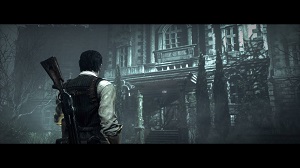 It’s that last point which is the most pertinent, as it’s The Evil Within‘s now notorious black bars that are at the root of a lot of its problems. Imitating the 2.35:1 aspect ratio (Albeit at a slightly inaccurate 2.5:1), it aspires to a cinematic look and fails for the simple fact that this is a game, and in a game you actually need to be able to see things easily. Combined with a camera that hangs just a little bit too snugly to Castellanos’s back, it results in a severely limited field of view and reduces your vertical awareness to pretty much nil, a problem when the game uses verticality in its level design: environmental puzzles that require you to look up or down for platforms, switches and the like feel more obnoxious than they should simply because looking around requires more work than it should. It becomes less about observing what’s available and more about fighting the camera to see what’s being hidden from you, a moot point in practical terms perhaps, but an important psychological factor that feels intended to encourage a sense of claustrophobia but rapidly becomes annoying.
It’s that last point which is the most pertinent, as it’s The Evil Within‘s now notorious black bars that are at the root of a lot of its problems. Imitating the 2.35:1 aspect ratio (Albeit at a slightly inaccurate 2.5:1), it aspires to a cinematic look and fails for the simple fact that this is a game, and in a game you actually need to be able to see things easily. Combined with a camera that hangs just a little bit too snugly to Castellanos’s back, it results in a severely limited field of view and reduces your vertical awareness to pretty much nil, a problem when the game uses verticality in its level design: environmental puzzles that require you to look up or down for platforms, switches and the like feel more obnoxious than they should simply because looking around requires more work than it should. It becomes less about observing what’s available and more about fighting the camera to see what’s being hidden from you, a moot point in practical terms perhaps, but an important psychological factor that feels intended to encourage a sense of claustrophobia but rapidly becomes annoying.
It also impacts the game’s combat. While the game encourages survival gameplay with its limited ammo and abundance of environmental puzzles and traps, it is equally reliant on the shooting and punching of its abundant undead and oddly large number of bosses (Some of the longer levels involving three or four boss battles). Unfortunately, the lack of situational awareness caused by the narrow field of view engenders a disorienting and artificial sense of difficulty, especially when you start encountering enemies who shoot at you from above. Melee is even more awkward, with the too-close camera displaying an infuriating habit of pushing the enemy out of frame, leaving you looking up your own nose as you flail desperately offscreen, unable to see the inevitable, unblockable counterattacks. While sneaking is the ideal approach, the stealth mechanics aren’t always successful – case in point, the numerous bottles strewn around the place that are meant to be thrown to cause distractions, but which went unnoticed by most enemies during my playthrough.
Not helping matters are the unwieldy controls, with supposedly seasoned detective Castellanos lurching hither and tither in an attempt to pick up objects lying around (thanks to weirdly fiddly UI prompts) and unable to run more than a couple of seconds at a time without collapsing into a wheezing mess. While you can collect jars of mysterious green gel to upgrade yourself across an initially impressive range of movement, weaponry and crafting related stats, very few of these upgrades seem to make much of a difference to your manoeuvrability or survivability in any meaningful way; it’s enough to keep you more or less on par with the game’s increasing difficulty and progressively tougher enemies, but allows you no moments of real empowerment.
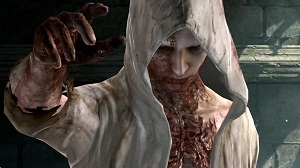 Some may argue that that is the point, that it’s the game’s job as a horror title to keep you feeling vulnerable. But if this is so, one has to question the point of having an upgrade system in the first place because the game is much more successful at finding ways to kill you in one shot than empowering you to fight back. The Evil Within is a game that just loves its insta-kills, available either from its many bosses or from the traps dotting each stage, some beating the Saw movies in terms of fanciful complexity. Rooms full of rotating saws, gigantic razorblade fans, Raiders-style arrow walls: if it’s big, sharp and a feat of engineering, The Evil Within has it and will have no problems dicing you with it at every available opportunity. While these threats can be navigated with care, again the limited field of view often means that these traps are sprung with no warning, making proceedings just as reliant on trial and error than rewarding care and observation.
Some may argue that that is the point, that it’s the game’s job as a horror title to keep you feeling vulnerable. But if this is so, one has to question the point of having an upgrade system in the first place because the game is much more successful at finding ways to kill you in one shot than empowering you to fight back. The Evil Within is a game that just loves its insta-kills, available either from its many bosses or from the traps dotting each stage, some beating the Saw movies in terms of fanciful complexity. Rooms full of rotating saws, gigantic razorblade fans, Raiders-style arrow walls: if it’s big, sharp and a feat of engineering, The Evil Within has it and will have no problems dicing you with it at every available opportunity. While these threats can be navigated with care, again the limited field of view often means that these traps are sprung with no warning, making proceedings just as reliant on trial and error than rewarding care and observation.
But then again, in many ways the game is about shock value. This is also evidenced by its convoluted and rambling story which often feels more concerned with one-upping itself in the craziness stakes than giving the player a whole lot to relate to, with its one genuinely affecting revelation (The backstory of mute ghostly antagonist Ruvik) coming too early and not built on in any interesting way. This has a knock-on effect on the general pacing of the game, which generates fleeting tension through randomness but is way too skittish to have a lasting effect. The design contributes to this erratic pacing, with its fifteen chapters noticeably varying in length. Throw in a few self-consciously ‘gamey’ conceits (such as Castellanos being a mechanical whizkid who can turn scrap metal into exploding death bolts yet who is incapable of carrying more than a handful of matches at a time) and you get a game that feels unfocused.
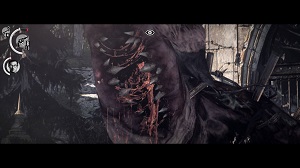 Even the game’s visuals feel like someone somewhere should’ve thought things through a little more before going forward. While it has good lighting and some interesting environments, poor texture work abounds along with bafflingly frequent framerate dips on PS4, even in its quieter moments. While some have latched onto the idea that the black bars are there to make it easier on the consoles’ supposedly inferior CPUs, this doesn’t explain why it still runs poorly with releases such as Metro Redux and Infamous: Second Son leaving it in the dust in looks and smoothness, both using the full screen. At the end of the day poor optimization seems to be the culprit (with the PC version reportedly faring little better).
Even the game’s visuals feel like someone somewhere should’ve thought things through a little more before going forward. While it has good lighting and some interesting environments, poor texture work abounds along with bafflingly frequent framerate dips on PS4, even in its quieter moments. While some have latched onto the idea that the black bars are there to make it easier on the consoles’ supposedly inferior CPUs, this doesn’t explain why it still runs poorly with releases such as Metro Redux and Infamous: Second Son leaving it in the dust in looks and smoothness, both using the full screen. At the end of the day poor optimization seems to be the culprit (with the PC version reportedly faring little better).
There are still things to be enjoyed about The Evil Within: the roundly excellent sound design for example, and occasional quieter moments when the art direction and some fun puzzles succeed in building an enjoyably unsettling atmosphere. However, you can usually rely on an insta-death or another cramped, fumbling boss fight round the corner to break the spell and usher frustration back in. It’s easy to see the game appeal to players looking for a slice of old-fashioned slice of survival horror, but even in those terms it lacks of the sense of focus and subtlety of design that helped define the greats of the genre. What remains is full of of sound and fury, signifying a grind.
Rating: 




Out of a Possible 5 Stars
